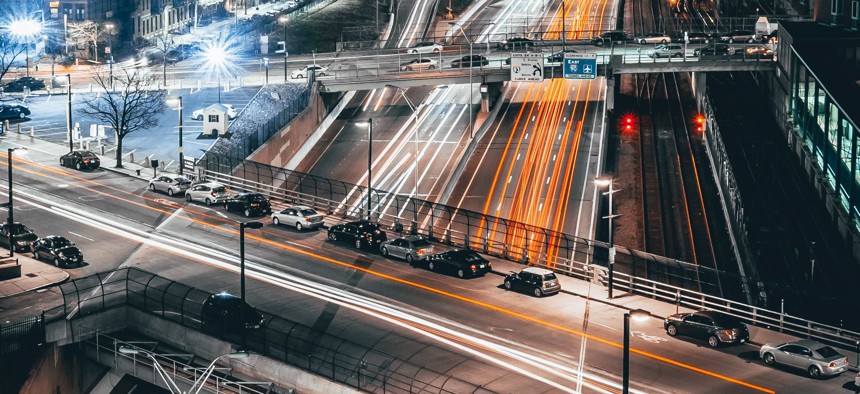Measuring the Cost of a State’s Car Economy

Traffic in Boston. Shutterstock
A new study attempts to come up with a dollar figure for how much cars, trucks and roads cost Massachusetts each year.
When governments weigh whether to invest in infrastructure like rail transit, bike lanes, and other public works meant to provide alternatives to car and truck transportation, the price tag for the proposed projects is often a key part of the debate.
A new working paper from researchers at the John F. Kennedy School of Government at Harvard attempts to provide some additional context for these sorts of deliberations. It offers estimates for the existing cost of Massachusetts’ “vehicle economy”—including nearly 37,000 miles of roads, parking areas and 4.5 million cars and light trucks.
The estimates take into account direct costs to state and local governments, such as road upkeep, snow removal, and emergency services. They also incorporate land use costs and social and economic costs, like traffic delays, pollution, and injuries and deaths from crashes. Private consumer costs for financing and operating vehicles are factored in as well.
Tallying up all of these categories, the researchers concluded that the total estimated cost each year of the vehicle economy in Massachusetts is about $64 billion.
To provide a reference point for the size of that sum, the state of Massachusetts in fiscal year 2019 was slated to spend about $59 billion, including federal funds and bond proceeds, to run the government and invest in infrastructure, according to figures compiled by the National Association of State Budget Officers.
“The public costs of the vehicle economy are substantial,” the paper says.
Injuries and deaths alone account for about $10.5 billion of the total estimate, the value of land for parking and roads about $8.7 billion and lost productivity due to time spent in traffic about $4.6 billion. Consumers, meanwhile, subsidize an estimated $3.9 billion in annual costs related to the construction and maintenance of private non-residential parking lots, the study says.
A group of graduate students working with Linda Bilmes, a professor at the Kennedy School, authored the paper. As she discussed the study this week, Bilmes emphasized that it should not be interpreted as “anti-car,” or seen as implying that the cost of cars to society is too much.
The paper makes clear that it is not intended to be a cost-benefit analysis and says that other research would be needed to quantify the benefits of the vehicle economy.
“What it’s trying to say is that, ‘the cost of cars is not free,’” Bilmes said. “Right now, very often, the conversation is conducted as if the cost of roads is zero,” she added. “That’s not correct.”
The hope with the study, she explained, is that it will help to broaden future discussions about the expenses and tradeoffs associated with different types of transportation investments.
U.S. Rep. Seth Moulton, a former student of Bilmes’, requested the study. Moulton, a Democrat from Massachusetts, said in an emailed statement that he believes building new rail infrastructure could help to alleviate heavy traffic congestion in the region he represents north of Boston.
“A lot of people point to the cost of a rail system as the excuse not to do it,” he said. “They advocate for wider roads and other short-sighted fixes, but the truth is we pay massive amounts to subsidize car travel and don't even know it.”
The study, Moulton added, “finally put a price tag on driving.”
Bilmes’ prior research has delved into topics like coming up with an economic valuation for U.S. national parks, and examining the costs of the wars in Iraq and Afghanistan. One thing that struck her with the vehicle economy study, she said, is how “fragmented” the costs were.
The costs were spread across state and local government and a range of categories—like road maintenance, debt service and parking. Local costs were difficult to pull together, she added, in part due to differences in how municipalities manage and track transportation spending.
Bilmes suggested that there are opportunities for further research that looks at what share of vehicle-related costs are shouldered by people at different income levels. “Generally, everybody is paying the cost of the car economy,” she said. “There are a lot of costs that non-car-owners have to bear for cars, which fall disproportionately on the poorer parts of the community.”
It’s possible that the approach the researchers used for their study could be adapted to develop similar estimates for other states. “I would think that it would be interesting for many states to look at this issue,” Bilmes said. “I’m sure we would find that each state is different.”
A copy of the working paper can be found here.
Bill Lucia is a Senior Reporter for Route Fifty and is based in Olympia, Washington.
NEXT STORY: For the First Time, a State Will Mandate Severance Pay During Mass Layoffs






